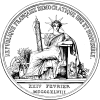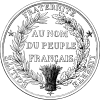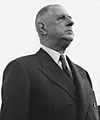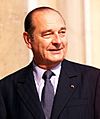French Fifth Republic facts for kids
Quick facts for kids
French Republic
Cinquième république française (French)
|
|||||||
|---|---|---|---|---|---|---|---|
| 1958–present | |||||||
|
Anthem: "La Marseillaise"
|
|||||||
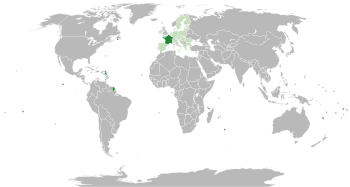
Location of France (dark green)
– on the European continent (green & dark grey) |
|||||||
| Capital and largest city
|
Paris 48°51.4′N 2°21.05′E / 48.8567°N 2.35083°E |
||||||
| Official language and national language |
French | ||||||
| Religion | Secular State In Alsace-Moselle |
||||||
| Government | Unitary semi-presidential constitutional republic | ||||||
| Emmanuel Macron | |||||||
| François Bayrou | |||||||
| Legislature | Parliament | ||||||
| Senate | |||||||
| National Assembly | |||||||
| Establishment | |||||||
| History | |||||||
|
• Current constitution
|
4 October 1958 (67 years) | ||||||
|
• Established
|
1958 | ||||||
|
• Disestablished
|
present | ||||||
| Currency | |||||||
| Date format | dd/mm/yyyy (AD) | ||||||
| Calling code | +33 | ||||||
| ISO 3166 code | FR | ||||||
| Internet TLD | .fr | ||||||
|
|||||||
The Fifth Republic (French: Cinquième République) is the way France is governed today. It's a type of republic (where people elect their leaders). This system started on October 4, 1958. It was created by Charles de Gaulle with a special set of rules called the Constitution of the Fifth Republic.
Before the Fifth Republic, France had a different system called the Fourth Republic. It didn't work very well. So, the Fifth Republic was created to be stronger. It's a 'semi-presidential' system. This means power is shared between two main leaders: the President (who is the head of state, like a country's main representative) and the Prime Minister (who is the head of government, in charge of day-to-day running of the country).
Contents
How France is Governed
Charles de Gaulle became the first President of the Fifth Republic in December 1958. He believed in a strong leader for the country. He felt the President should represent "the spirit of the nation."
The President's Role
Under the Fifth Republic, the President has important powers. The President can decide to end the term of the National Assembly (France's main law-making body) and call for new elections.
If the President's political party has the most seats in the National Assembly, the President usually sets the country's main policies. The Prime Minister then helps put these policies into action. The President can also choose a new Prime Minister or change other government ministers during their time in office.
Sometimes, the President and the National Assembly might be from different political parties. This situation is called cohabitation. When this happens, the President has to choose a Prime Minister from the party that has the majority in the National Assembly. This means the President and Prime Minister might not always agree on everything.
At first, presidential elections were held every seven years, and parliamentary elections every five years. This made cohabitation more likely. But since the year 2000, both presidential and parliamentary elections happen every five years. This usually means the President's party also wins the majority in the National Assembly, making cohabitation less common. However, it can still happen if the President calls for new parliamentary elections in the middle of their term.
History of the Fifth Republic
The Fifth Republic is one of the longest-lasting systems of government in France's history. It has been around for over 65 years. Before this, France had a long period of kings and queens, and then other republics like the Third Republic. The Fifth Republic is expected to become the second-longest French government system on August 8, 2028.
Images for kids
-
Former prime minister, Élisabeth Borne
-
Charles de Gaulle (1890–1970) Served 1959–1969
-
Alain Poher (1909–1996) Served 1969, 1974 (as interim)
-
Georges Pompidou (1911–1974) Served 1969–1974
-
Valéry Giscard d'Estaing (1926–2020) Served 1974–1981
-
François Mitterrand (1916–1996) Served 1981–1995
-
Jacques Chirac (1932–2019) Served 1995–2007
-
Nicolas Sarkozy (b. 1955) Served 2007–2012
-
François Hollande (b. 1954) Served 2012–2017
-
Emmanuel Macron (b. 1977) Incumbent since May 2017
See also
 In Spanish: Quinta República francesa para niños
In Spanish: Quinta República francesa para niños




